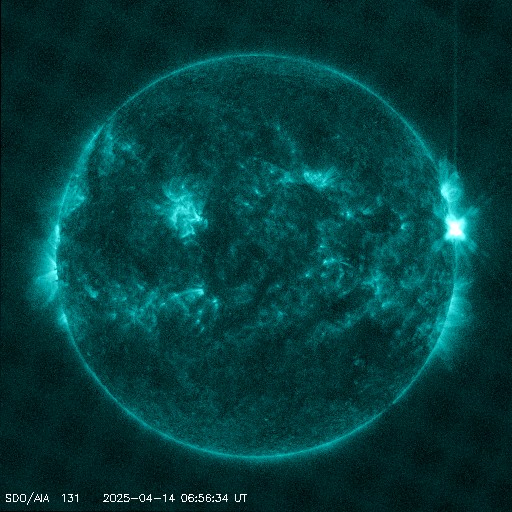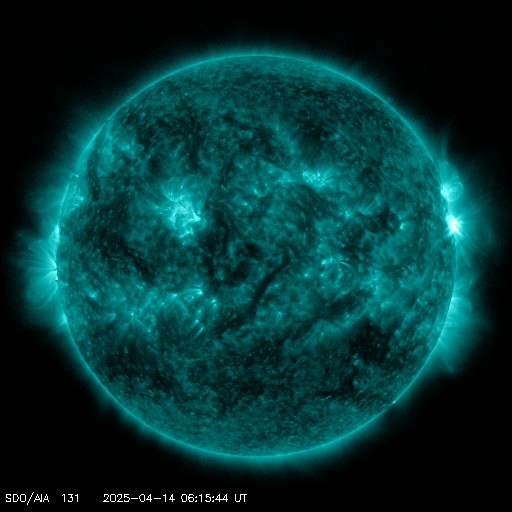Viewing archive of Saturday, 3 November 2001
Solar activity report
Any mentioned solar flare in this report has a scaling factor applied by the Space Weather Prediction Center (SWPC). Because of the SWPC scaling factor, solar flares are reported as 42% smaller than for the science quality data. The scaling factor has been removed from our archived solar flare data to reflect the true physical units.
Report of Solar-Geophysical Activity 2001 Nov 03 2200 UTCPrepared by the NOAA © SWPC and processed by SpaceWeatherLive.com
Joint USAF/NOAA Report of Solar and Geophysical Activity
SDF Number 307 Issued at 2200Z on 03 Nov 2001IA. Analysis of Solar Active Regions and Activity from 02-2100Z to 03-2100Z
Solar activity was low during the past 24 hours due to
numerous C-class flares. Regions 9687 (S19E49) and 9682 (N12W50)
combined to produce a C5 event at 0741 UTC. An additional C5/Sf was
produced by 9682 at 0935 UTC. Region 9682 was quieter today than
yesterday and appears to have decreased slightly in area. Region
9687 also was quieter today. Preliminary analysis of 9687 indicates
at least a beta-gamma magnetic class, and there may possibly be a
weak delta sunspot in the group. Region 9684 (N05W15) showed some
spot rotation and some development of the leader spot. A partial
halo CME, reported by LASCO, entered the C2 field of view at 01/2230
UTC and was apparently associated with yesterday's M1 event out of
Region 9682.
IB. Solar Activity Forecast
Solar activity is expected to be low
to moderate during the next three days. There is a slight chance for
a major flare or a proton producing flare. Regions 9682, 9684, and
9687 continue to be the major groups to watch for energetic flare
activity.
IIA. Geophysical Activity Summary 02-2100Z to 03-2100Z
The geomagnetic field was quiet during the past 24 hours.
IIB. Geophysical Activity Forecast
The geomagnetic field is
expected to be quiet to unsettled during the next 24-36 hours. An
increase to unsettled to slightly active levels is forecast for the
second and third days in response to the partial halo CME event that
occurred late on 1 November.
III. Event Probabilities 04 Nov to 06 Nov
| Class M | 70% | 70% | 70% |
| Class X | 20% | 20% | 20% |
| Proton | 20% | 20% | 20% |
| PCAF | yellow | ||
IV. Penticton 10.7 cm Flux
Observed 03 Nov 216 Predicted 04 Nov-06 Nov 215/210/215 90 Day Mean 03 Nov 206
V. Geomagnetic A Indices
Observed Afr/Ap 02 Nov 006/006 Estimated Afr/Ap 03 Nov 005/005 Predicted Afr/Ap 04 Nov-06 Nov 005/008-015/015-015/015
VI. Geomagnetic Activity Probabilities 04 Nov to 06 Nov
| A. Middle Latitudes | |||
|---|---|---|---|
| Active | 15% | 35% | 35% |
| Minor storm | 10% | 20% | 20% |
| Major-severe storm | 05% | 10% | 10% |
| B. High Latitudes | |||
|---|---|---|---|
| Active | 15% | 40% | 40% |
| Minor storm | 10% | 25% | 25% |
| Major-severe storm | 05% | 10% | 10% |
All times in UTC
Current data suggests there is a slight possibility for aurora to appear at the following high latitude regions in the near future
Gillam, MBLatest news
Latest forum messages
2025/04/12-13 Filament CMEs 2025/04/16 G2 Watch 46Ask your obscure/"stupid" space weather questions. 351Incoming & Unnumbered Active Regions 1708Filaments and prominences 61AR 4055 99
More topicsSupport SpaceWeatherLive.com!
A lot of people come to SpaceWeatherLive to follow the Sun's activity or if there is aurora to be seen, but with more traffic comes higher server costs. Consider a donation if you enjoy SpaceWeatherLive so we can keep the website online!

Latest alerts
Monday, 14 April 2025
23:15 UTC - Geomagnetic activity
Active geomagnetic conditions (Kp4) Threshold Reached: 23:01 UTC
07:09 UTC - Solar flare
Moderate M4.28 flare from sunspot region 4055
06:48 UTC - Radio Blackout
Minor R1 radio blackout in progress (≥M1 - current: M1.53)
06:24 UTC - Solar flare
Moderate M1.49 flare from sunspot region 4055
06:06 UTC - Radio Blackout
Minor R1 radio blackout in progress (≥M1 - current: M1.16)
Space weather facts
| Last X-flare | 2025/03/28 | X1.1 |
| Last M-flare | 2025/04/14 | M4.2 |
| Last geomagnetic storm | 2025/04/06 | Kp5 (G1) |
| Spotless days | |
|---|---|
| Last spotless day | 2022/06/08 |
| Monthly mean Sunspot Number | |
|---|---|
| March 2025 | 134.2 -20.4 |
| April 2025 | 128.8 -5.4 |
| Last 30 days | 129.1 -15.1 |





